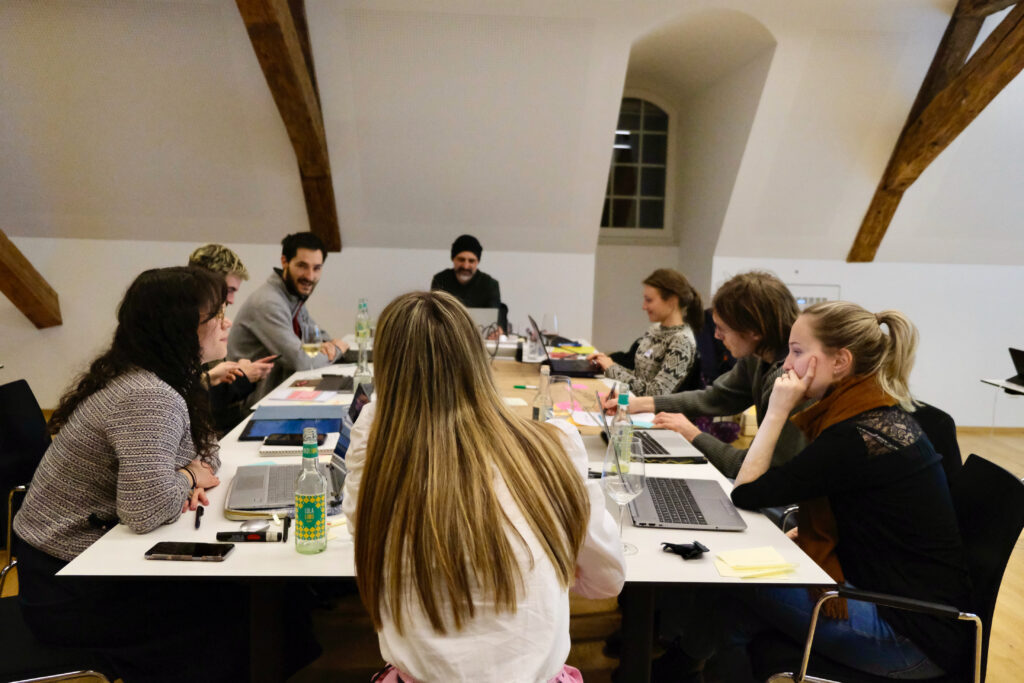Authors: Lhazen Chirring, Era Bislimi, Maher Akraa-Meyer, Samuel Zurbriggen, Gabriela Niederberger, Lukas Umiker, Salome Locher, Sara Kashir, Yvonne Mattmann, Mara Danz
Bringing together 25 young thinkers from a variety of academic fields, we used Policy Kitchen to develop visions for how artificial intelligence is likely to affect their futures. This four-part blog series on how novel tools will shape our lives and societies was rendered possible by the Hirschmann foundation.
Thanks to algorithms and personal assistants such as Siri, artificial intelligence (AI) is playing a growing role in various aspects of our daily lives. A notable addition to this technological landscape is ChatGPT, launched in November 2022. The chatbot has captivated human audiences with its skilful dialogues, but has also created a greater hype around AI technologies in general. As AI continues to transform industries, professionals and educational institutions, it is important to examine its potential impact on creativity and innovation. Can artificial intelligence stifle or enhance creativity and innovation? When we asked ChatGPT itself, it replied that both are possible.
Through generative natural language processors, we can simulate the way we communicate. However, it is important to recognise that the machine’s text generation is rooted in numerical calculations. There are calculations about how words relate to each other and reflect the sum of the greatest accuracy. Ethical questions arise when dealing with AI as the machine has no human-like awareness of what it is actually writing. ChatGPT makes no distinction between right and wrong. So who is responsible for mistakes?
What ChatGPT can(‘t) do
ChatGPT or other AI chatbots can free us from monotonous tasks and allow us to spend more time on creative endeavours and innovation. It creates the opportunity for more interaction with others and fosters a realm of creativity. In our everyday study life, AI can assist in information retrieval and provide inspiration for text generation. This support extends to different contexts, such as the creation of essays and papers, as well as providing guidance on refining students‘ work to ensure it is ready for submission.
Chatbots can also recognise patterns in data and generate entirely new content, giving them the ability to take on creative tasks. AI can make connections in data and help develop new ideas and insights into topics that we would never have been able to discover ourselves. However, there are some drawbacks to the AI powered chat robot that could affect us. One drawback is the domain of knowledge that goes into ChatGPT. ChatGPT is known to only use data up to the year 2021, so the data output could be seen as outdated or lacking knowledge of current affairs. ChatGPT could also contain sensitive information that is not regulated and could be easily accessible for misuse by users. Finally, there is a lack of quality control as ChatGPT does not have the ability to understand the level of quality of its data input.
Ethical considerations and the need for guidelines
There are ethical considerations that need to be addressed in relation to the use of AI chatbots. Grazia Murtarelli et al. emphasised the importance of chatbots interacting with humans in a socially acceptable way. Challenges include the need to account for individual differences in communication style and avoid unintentional bias.
A careful diagnostic analysis of ChatGPT’s ethical performance by Terry Yue Zhuo et al. revealed some ethical concerns, such as potential biases in the training data and a lack of transparency in the decision-making process. Furthermore, these authors recommend that AI chatbot developers carefully consider issues such as transparency, fairness, and bias in the development and deployment of these systems to ensure that they meet ethical standards.
Today, there are no binding guidelines to follow for users which guarantee an ethical use of AI technologies and promote a universal societal good. Only a collaborative approach to the design of chatbots, involving multiple stakeholders, will ensure that ethical considerations are adequately addressed and meet these standards. It is important to note that research needs to continue in this critical area of ethics and AI.
Therefore, discussions about ChatGPT and its impact on society should be initiated among the general public, including organisations, universities, schools and political actors. This discourse will shape how we use ChatGPT (and other AI-based chatbots) in the future, as it will affect us all. It is therefore crucial to engage all parties, not just those at the forefront of technological development. Currently, ChatGPT’s parent company, OpenAI, relies on usage policies and a charter to set usage standards, but both frameworks are very general and do not lead to legal repercussions for all kinds of breaches. This is not enough – guidelines for the use of ChatGPT need to be established democratically by relevant stakeholders. They should then be implemented in organisations, universities, schools and private life. As technology continues to evolve, the guidelines will need to be regularly updated to reflect current circumstances.
What comes next?
It is imperative to strike a sensible balance in the use of ChatGPT and determine its appropriate application. It is important not to rely solely on AI, but to question it with critical awareness. As with any new technology, end users must also get accustomed to the potentials and pitfalls of generative AI, learning how to write effective prompts and also how to screen for (mis-)use of AI technology in publicly available materials. Researchers recommend looking for telltale signs such as an absence of personalisation in a text, a lack of coherence and flow. Our scrutiny must extend to comparing different sources and also responses generated by different language models as well as relying on technological solutions, such as plagiarism-detection or fact-checking tools to identify faulty information.
Let’s also recall that every person has a unique tone and style, has the human advantage of being able to recall experiences and emotions and can thus still differentiate their writing from machine-generated texts. ChatGPT or other AI-based chatbots can serve as idea generators that individuals can consciously use in their day-to-day business. AI can enhance an author’s skill, range and background knowledge and should thus be seen as a valuable resource.
We thank the Hirschmann foundation for their kind support of this four-part blog series.











